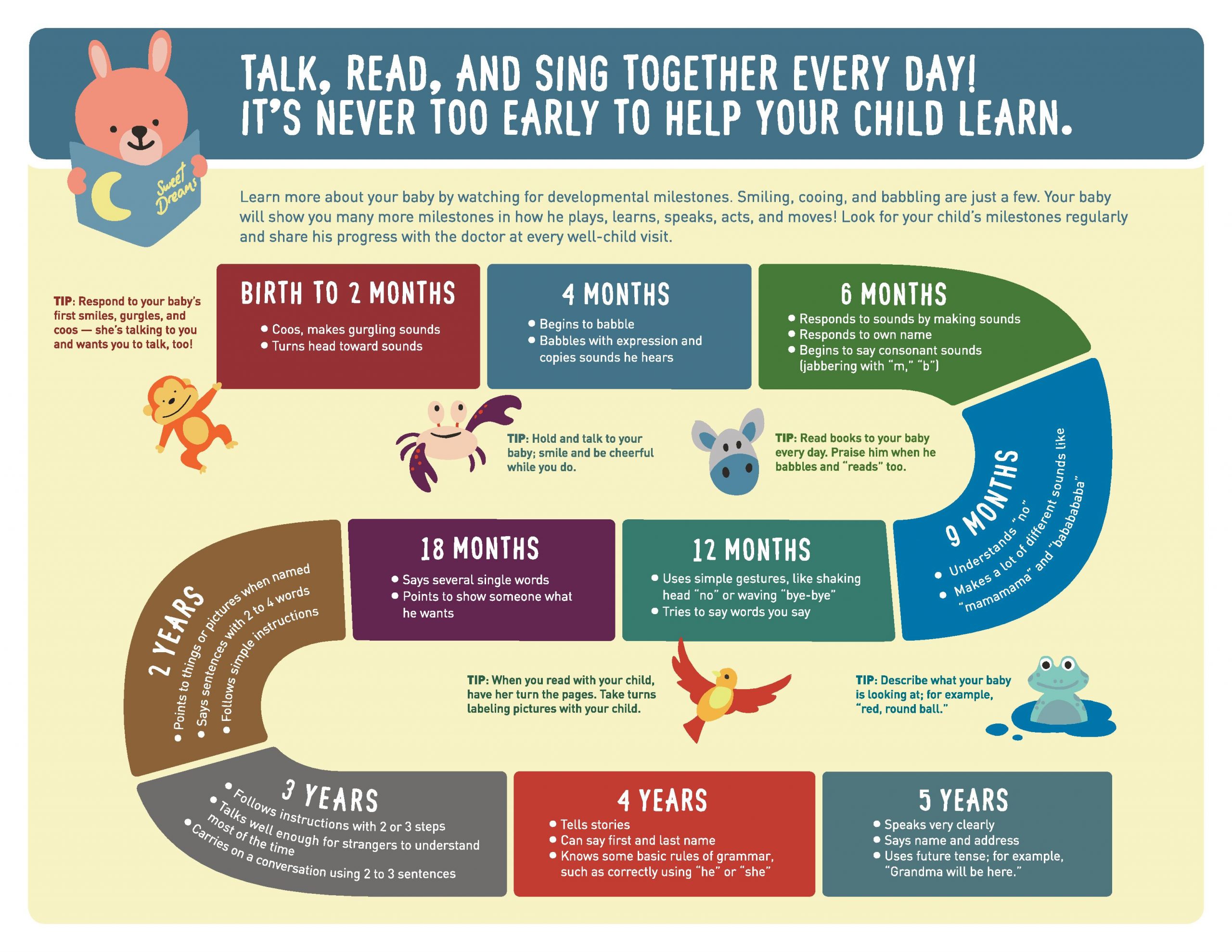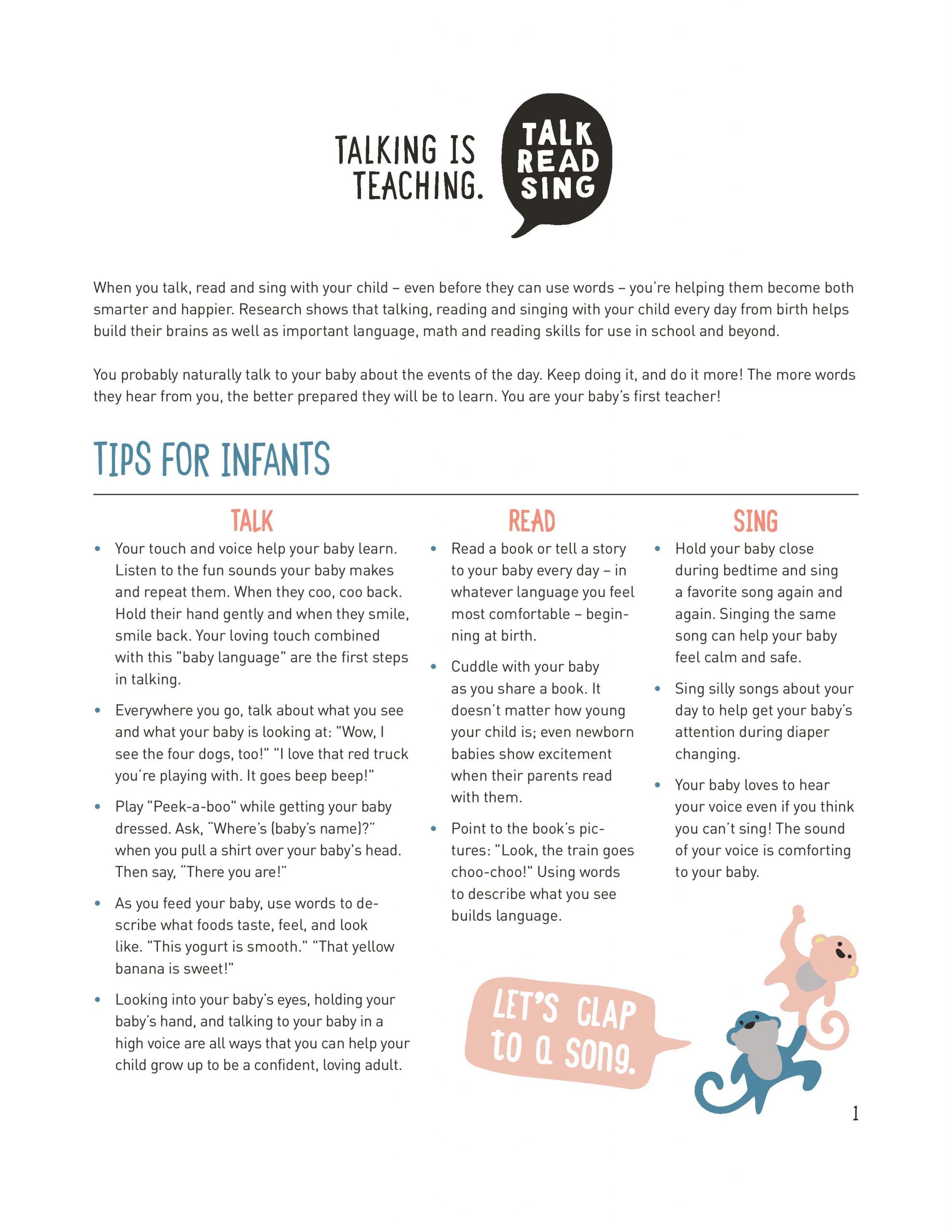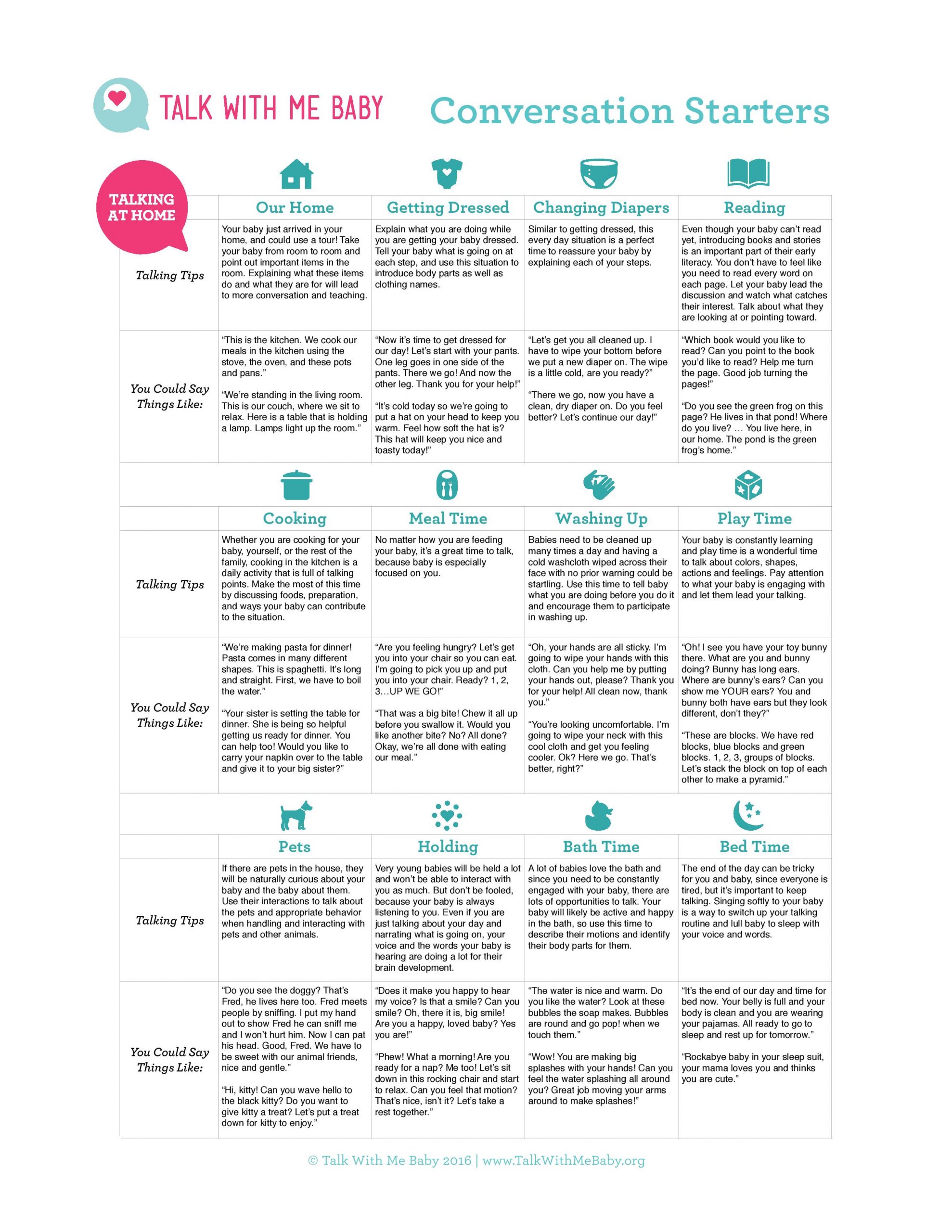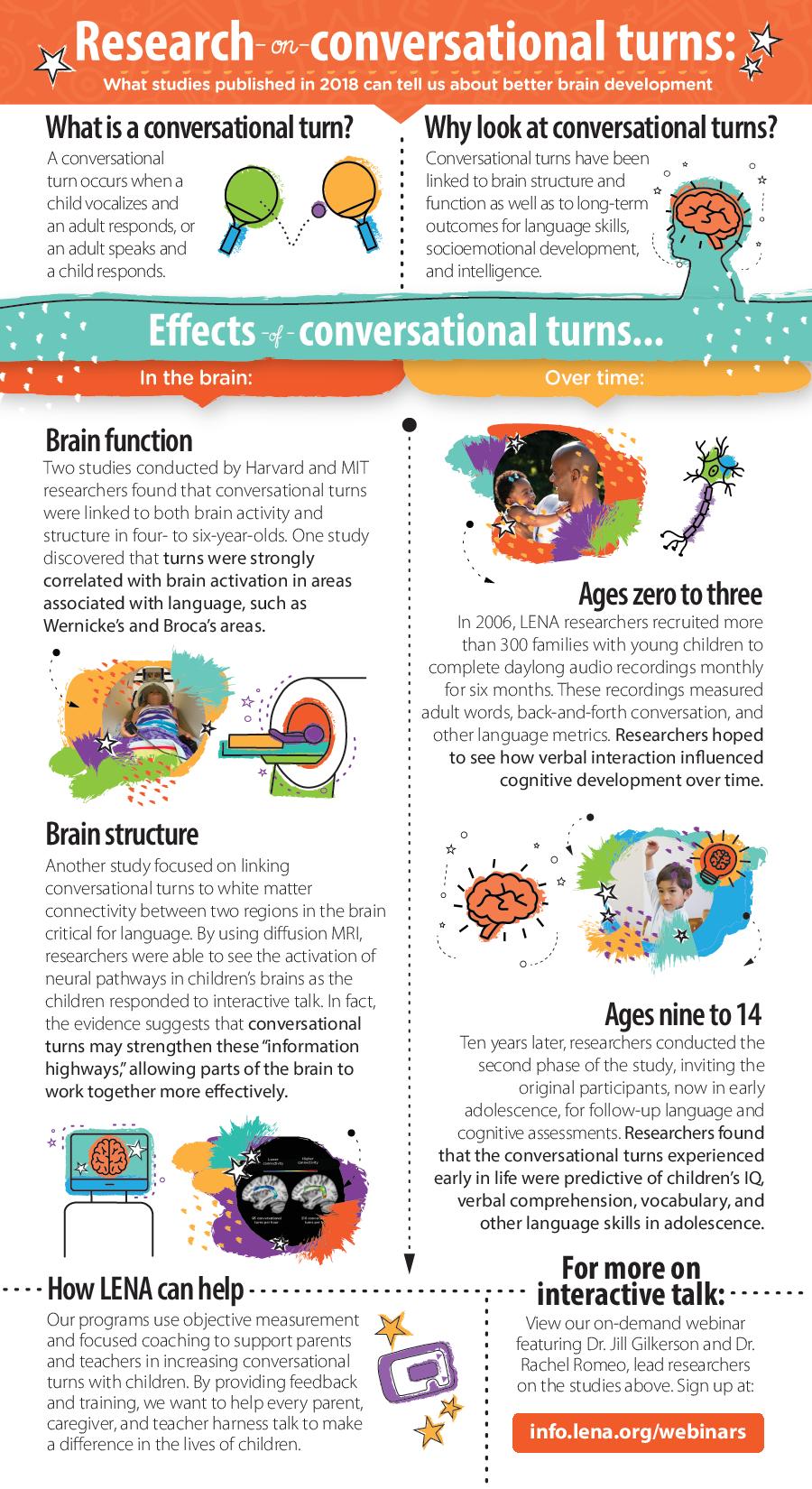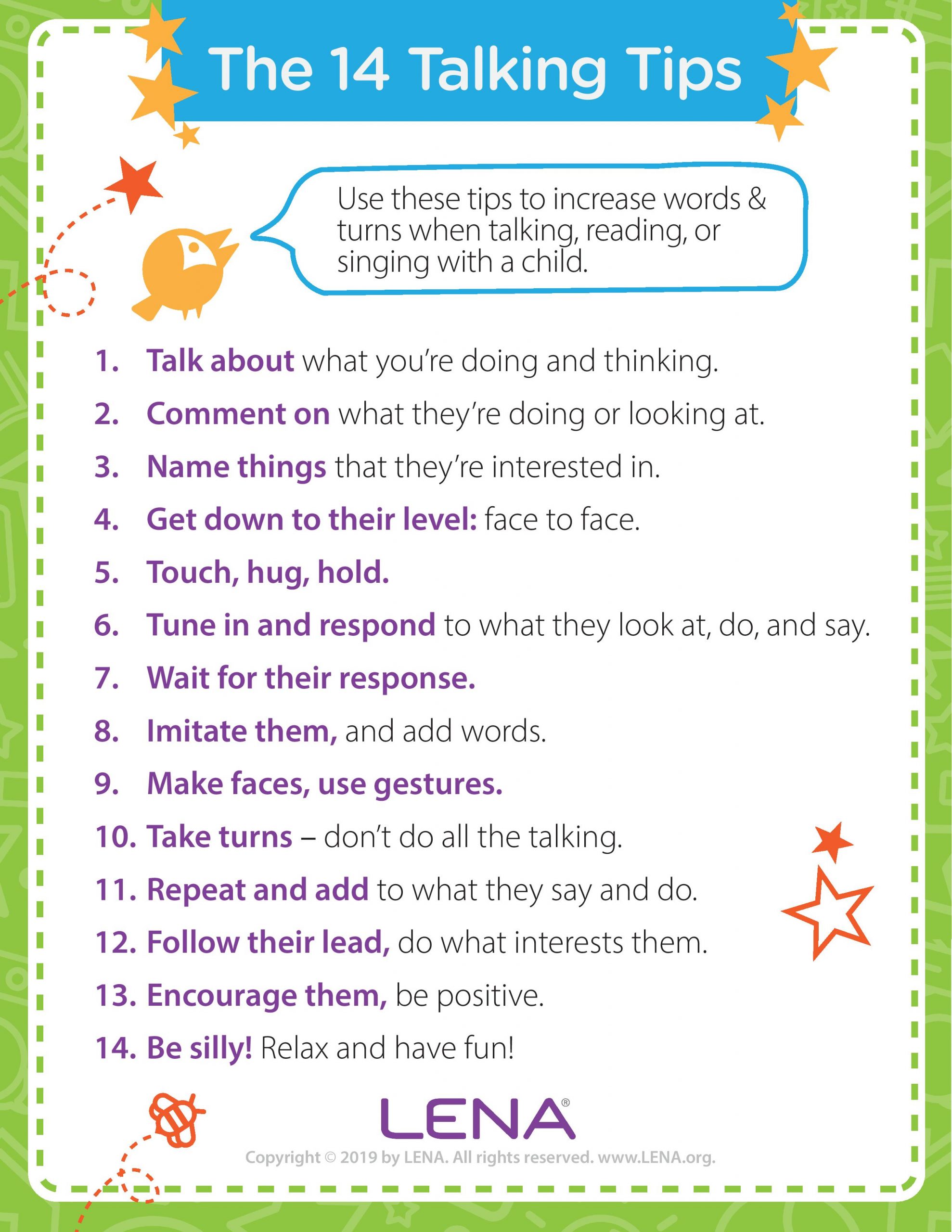Resources for Parents
Why Early Talk Matters
We’ve all heard about the importance of talking to children. But why does it matter? During the first 3 years of life over 85% of physical brain growth happens. Talking to your child provides the necessary language nutrition to encourage brain development for academic success.
In the groundbreaking Hart and Risley (1995) study that formed the basis for our current understanding of the Word Gap they discovered that the quantity of words spoken to a child in the first three years of life were strongly associated with a child’s language skills, vocabulary size and IQ later in life.
TMW – Talk and Interaction
Thirty Million Words (2019, Jan. 29). Talk and Interaction.
Retrieved from YouTube.
Does Talking More Really Make a Difference?
Yes! One of the best ways to prepare children for academic success is by talking more. Studies have found a tight link between early language exposure and later literacy development, as well as improved performances in math, emotion regulation, and long term academic outcomes.
Birth - 2 Years
- Say sounds like “ma,” “da,” and “ba.” Try to get your baby to say them back to you.
- Look at your baby when he makes sounds. Talk back to him, and say what he says. Pretend to have a conversation.
- Respond when your baby laughs or makes faces. Make the same faces back to her.
- Teach your baby to do what you do, like clapping your hands and playing peek-a-boo.
- Talk to your baby as you give him a bath, feed him, and get him dressed. Talk about what you are doing and where you are going. Tell him who or what you will see.
- Point out colors and shapes.
- Count what you see.
- Use gestures, like waving and pointing.
- Talk about animal sounds. This helps your baby connect the sound and the animal. Use words like “The dog says woof-woof.”
- Add on to what your baby says. When your baby says, “Mama,” say, “Here is Mama. Mama loves you. Where is baby? Here is baby.”
- Read to your child. You don’t have to read every word, but talk about the pictures. Choose books that are sturdy and have large colorful pictures. Ask your child, “What’s this?” and try to get him to point to or name objects.
2 - 4 Years
- Speak clearly to your child. Model good speech.
- Repeat what your child says to show that you understand. Add on to what she says. Use words like, “Want juice? I have juice. I have apple juice. Do you want apple juice?”
- It’s okay to use baby talk sometimes. Be sure to use the adult word too. For example, “It is time for din-din. We will have dinner now.”
- Cut out pictures of favorite or familiar things. Put them into categories, like things to ride on, things to eat, and things to play with. Make silly pictures by mixing and matching pictures. Glue a picture of a dog behind the wheel of a car. Talk about what is wrong with the picture and ways to “fix” it.
- Help your child understand and ask questions. Play the yes–no game. Ask questions such as, “Are you Marty?” and “Can a pig fly?” Have your child make up questions and try to fool you.
- Ask questions that include a choice. “Do you want an apple or an orange?” “Do you want to wear your red shirt or your blue shirt?”
- Help your child learn new words. Name body parts, and talk about what you do with them. “This is my nose. I can smell flowers, brownies, and soap.”
- Sing simple songs, and say nursery rhymes. This helps your child learn the rhythm of speech.
- Place familiar objects in a box. Have your child take one out and tell you its name and how to use it. “This is my ball. I bounce it. I play with it.”
- Show pictures of familiar people and places. Talk about who they are and what happened. Try making up new stories.
4 - 6 Years
- Pay attention when your child talks to you.
- Get your child’s attention before you talk.
- Praise your child when she tells you something. Show that you understand her words.
- Pause after speaking. This gives your child a chance to respond.
- Keep helping your child learn new words. Say a new word, and tell him what it means, or use it in a way that helps him understand. For example, you can use the word “vehicle” instead of “car.” You can say, “I think I will drive the vehicle to the store. I am too tired to walk.”
- Talk about where things are, using words like “first,” “middle,” and “last” or “right” and “left.” Talk about opposites like “up” and “down” or “on” and “off.”
- Have your child guess what you describe. Say, “We use it to sweep the floor,” and have her find the broom. Say, “It is cold, sweet, and good for dessert. I like strawberry” so she can guess “ice cream.”
- Work on groups of items, or categories. Find the thing that does not belong in a group. For example, “A shoe does not go with an apple and an orange because you can’t eat it. It is not round. It is not a fruit.”
- Help your child follow two- and three-step directions. Use words like, “Go to your room, and bring me your book.”
- Ask your child to give directions. Follow his directions as he tells you how to build a tower of blocks.
- Play games with your child such as “house.” Let her be the parent, and you pretend to be the child. Talk about the different rooms and furniture in the house.
- Watch movies together on TV or a tablet. Talk about what your child is watching. Have her guess what might happen next. Talk about the characters. Are they happy or sad? Ask her to tell you what happened in the story. Act out a scene together, or make up a different ending.
- Use everyday tasks to learn language. For example, talk about the foods on the menu and their color, texture, and taste when in the kitchen. Talk about where to put things. Ask her to put the napkin on the table, in your lap, or under the spoon. Talk about who the napkin belongs to. Say, “It is my napkin.” “It is Daddy’s.” “It is Tamara’s.”
- Go grocery shopping together. Talk about what you will buy, how many things you need, and what you will make. Talk about sizes, shapes, and weight.

Talking With Your Baby
Early language exposure has benefits to the brain. Recent research has even shown babies hear language in the womb. So how can you make the most of conversations with your baby?
How to Talk to Your Baby
– Vary your pitch, use emotion, and exaggerated vowels. This is called Baby Talk, or Infant Directed Speech. Babies prefer to listen to this type of speech and it helps_________.
– Use correct word production to communicate with your baby. Children are learning from everything they see and hear, so each time you talk to them you are modeling for their future learning!
– Think about the quality of language you’re providing. Use diverse vocabulary and _____. A great way to introduce new vocabulary is through reading and pretend play.
– Follow the baby’s lead and adapt your language to match
– Talk to them often and imitate the sounds they make. This helps babies understand they can communicate and it helps them learn the more complex sounds that make up speech.
– Use gestures and facial expressions to
– Have a conversation with your baby. That’s right, you can have a conversation. When your baby looks or gestures to something talk about what they’re seeing. When they make a sound respond just like you would with another person.
Activities for You and Your Baby
Share words and stories. Place objects or pictures around your baby and label what he or she sees. Read a simple board book with your child and describe the pictures.
Choose developmentally appropriate toys. Early play is an important language learning opportunity for infants. Talk about what your baby sees, what you feel, and how you’re playing with the toy.
Quality of language is as important as quantity. The words children hear are important, but the amount of conversational exchanges they experience are just as meaningful. A conversation with your infant could be responding to what you think they are saying, imitating their vocalizations, or whatever meaningful back and forth makes your child happy.
Read early and read often. They love the sound of your voice and can explore the ________—
Benefits of Using Baby Talk & More Resources
Some of the benefits of using Baby Talk:
Several studies have found that babies will pay attention longer to an adult who is using Baby Talk than to someone using normal adult speech (Spinelli, 2017).
Brain scans on infants revealed higher amounts of brain activity for babies listening to infant-directed speech, than for normal speech (Naoi et.al., 2012).
Studies have shown more successful word learning in babies who heard Baby Talk vs normal adult speech (Ma et al., 2011).
People use clearer speech in Baby Talk which benefits baby’s language acquisition (Kuhl, 2000).
More Resources:
Talking With Toddlers
How to Talk to Your Toddler
, By the time your child 2-3 years old, they’re probably talking a lot more. Encourage them to keep talking by singing, telling stories, having a conversation, or reading.
Talk about the ordinary things you do. For example, “I’m putting these clothes in the washing machine so they will get clean.” or “After I put on my coat I’ll put on my gloves.” Talking about
Be face-to-face – one of the best ways to let your child know that you want to talk is to be face-to-face. This means getting on the floor during play time, sitting together at the table, or moving wherever your child moves. Making eye contact shows your child that you’re listening!
The quality of language children hear is incredibly important to vocabulary development. Children benefit from hearing more complex vocabulary throughout their childhood.
Use positive language with your child. It can be difficult to manage children, but using positive language and feedback statements has been shown to improve children’s developmental skills and learning capacity. So, instead of saying “no running” try “we use our walking feet in the house”, or instead of “_________.
Have a conversation! Children learn language and vocabulary most effectively when they are directly spoken to, less so from passive exposure like watching TV. Talk to your child about his day, if your child says she’s driving a car, ask her where she’s going, discuss what you think will happen next in the book you’re reading.
Play is a wonderful language learning opportunity for children. These everyday moments are a great way for children to listen, observe, and learn.
Activities for You and Your Toddler
Quality of language is as important as quantity. The words children hear are important, but the amount of conversational exchanges they experience are just as meaningful. Listen to what your toddler says and respond like you would with anyone you are talking to!
Share words and stories. Start a story and ask your child to finish it, or ask your child to tell you how to do something.
Shopping for groceries. There are lots of opportunities for talk at the grocery store. Talk about what your child sees, point out words, and let your child help shop!
Go on a walk. There is so much to see and talk about when you’re outside. Ask your child to
Choose language rich toys. Stuffed animals, blocks, or a kitchen set can provide many opportunities for you and your child to have a language rich play time.
More ideas for toys and what to talk about when playing with toddlers.
Read together. Books often have language and vocabulary that don’t naturally occur in everyday conversations. Read a story and talk about what’s happening to the characters and let your child ask questions.
Learn more about reading with your toddler.
Benefits of Talking to Your Toddler & More Resources
More Resources:
How to Make Every Home Activity a Language-Learning Activity
Child language development happens best in a language-rich environment where parents and caregivers talk to children frequently using a wide vocabulary. But building this environment can be difficult in this age of busy lifestyles and full-time work. Finding the time to spend with your children may be harder than many of us realize. Here are some tips and tricks that can make any environment language-rich:
Talk to your child during everyday activities. If you talk about what you’re doing and ask questions, even simple activities such as laundry or washing dishes can become a rich language experience.
Ask questions, but not too many. It’s important to foster children’s curiosity and engage them in conversation with questions. But they can also put too much pressure on children to talk. Commenting can be an effective way to keep talking while the child leads the activity.
Find language in unexpected places. Reading labels at the grocery store, talking about what you see while waiting for public transit, or singing a song about washing your hands. Any opportunity to read, talk, or sing can be a language rich one.
Use pretend play. This is a great oppotunity to develop a child’s imagination, and introduce vocabulary that you might not find in typical conversations.

